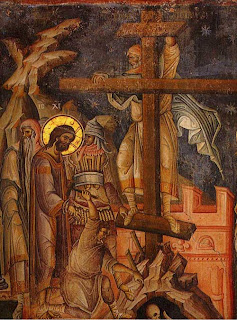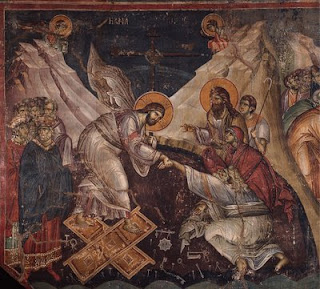 |
| Μανουήλ Πανσέληνος,Πρωτατο Αγ.Ορους 13ος αιώνας |
Πανσέληνος Μανουήλ
Μακεδόνας ζωγράφος. Έζησε γύρω στο 13ο με 14ο αι. στη Θεσσαλονίκη.
Περίφημες είναι οι τοιχογραφίες του στο ναό του Πρωτάτου στο Άγιο Όρος.
Γι` αυτό ακριβώς το έργο του θεωρήθηκε δίκαια ο δημιουργός της "Μακεδονικής Σχολής" και παραλληλίστηκε από πολλούς με τον Τζιότο και το Ραφαήλ.
Τα έργα του χαρακτηρίζονται από τη λιτότητα των χρωματισμών τους, την ευρύτητα του σχεδίου και τη μεγαλειώδη τους σύνθεση.
Σ` όλες σχεδόν τις προσωπογραφίες του αποδίδεται η σωστή εκφραστική σημασία με τη χρησιμοποίηση των ιδιαίτερων χρωματισμών και των φωτεινών τόνων.
Περίφημες είναι οι τοιχογραφίες του στο ναό του Πρωτάτου στο Άγιο Όρος.
Γι` αυτό ακριβώς το έργο του θεωρήθηκε δίκαια ο δημιουργός της "Μακεδονικής Σχολής" και παραλληλίστηκε από πολλούς με τον Τζιότο και το Ραφαήλ.
Τα έργα του χαρακτηρίζονται από τη λιτότητα των χρωματισμών τους, την ευρύτητα του σχεδίου και τη μεγαλειώδη τους σύνθεση.
Σ` όλες σχεδόν τις προσωπογραφίες του αποδίδεται η σωστή εκφραστική σημασία με τη χρησιμοποίηση των ιδιαίτερων χρωματισμών και των φωτεινών τόνων.
 |
| Μανουήλ Πανσέληνος,Πρωτατο Αγ.Ορους 13ος αιώνας |
Από την Ιστοσελίδα της Μακεδονικής Ι.Μ. Παντοκράτορος στο Μελισσοχώρι Θεσσαλονίκης..
 |
| Τοιχογραφία του Μανουήλ Πανσέληνου στον ναό του Πρωτάτου, στις Καρυές του Αγίου Ορους |
Η Μακεδονική Σχολή γεννήθηκε στην Κωνσταντινούπολη,
άνθισε κυρίως στην Μακεδονία με κέντρο την Θεσσαλονίκη και πέρασε και στη Σερβία.
Η Σχολή αυτή χαρακτηρίζεται για τον ρεαλισμό και την ελευθερία της.
Έχει ένταση, κίνηση και πλούσια χρωματολογία. Το πρόσωπο και τα ενδύματα είναι πλατειά φωτισμένα, γι' αυτό και την ονομάζουν «πλατειά τεχνοτροπία». Υποστηρίχθηκε η άποψη - χωρίς να είναι απόλυτο - ότι η τέχνη αυτή υπήρξε ιδιαίτερα συμπαθής στους λογίους, στις μορφωμένες τάξεις, τους αυλικούς.
Κύριοι εκφραστές της υπήρξαν ο Μανουήλ Πανσέληνος (ο οποίος αγιογράφησε το παρεκκλήσι του Αγίου Ευθυμίου Θεσσαλονίκης και το ναό του Πρωτάτου),
ο Μιχαήλ Αστραπάς και ο αδελφός του Ευτύχιος, που αγιογράφησαν στη Σερβία, ο Γεώργιος Καλλιέργης κ.α.
Στην ίδια εποχή ανήκει και το απαράμιλλο σε τέχνη και ομορφιά μνημείο της Μονής της Χώρας στην Κωνσταντινούπολη.
άνθισε κυρίως στην Μακεδονία με κέντρο την Θεσσαλονίκη και πέρασε και στη Σερβία.
Η Σχολή αυτή χαρακτηρίζεται για τον ρεαλισμό και την ελευθερία της.
Έχει ένταση, κίνηση και πλούσια χρωματολογία. Το πρόσωπο και τα ενδύματα είναι πλατειά φωτισμένα, γι' αυτό και την ονομάζουν «πλατειά τεχνοτροπία». Υποστηρίχθηκε η άποψη - χωρίς να είναι απόλυτο - ότι η τέχνη αυτή υπήρξε ιδιαίτερα συμπαθής στους λογίους, στις μορφωμένες τάξεις, τους αυλικούς.
Κύριοι εκφραστές της υπήρξαν ο Μανουήλ Πανσέληνος (ο οποίος αγιογράφησε το παρεκκλήσι του Αγίου Ευθυμίου Θεσσαλονίκης και το ναό του Πρωτάτου),
ο Μιχαήλ Αστραπάς και ο αδελφός του Ευτύχιος, που αγιογράφησαν στη Σερβία, ο Γεώργιος Καλλιέργης κ.α.
Στην ίδια εποχή ανήκει και το απαράμιλλο σε τέχνη και ομορφιά μνημείο της Μονής της Χώρας στην Κωνσταντινούπολη.
Από το Mount Athos.The Macedonian School
The Macedonian School had its centre in Thessaloniki and flourished in the 13th and 14th centuries. Its hallmarks are realism in the depiction of the figures, not only in their external features but also in the rendering of their inner world, particularly their pathos. The compositions are crowded, with all the figures moving in the space, which is extensive and rendered in striking depth.
Painters from Thessaloniki were invited to paint Athonite foundations, and they frescoed the Protaton, the katholika of the Great Lavra, Vatopedi, Chelandari, and Pantokrator, and the refectory and cemetery church of Pantokrator. There were many famous ateliers of the Macedonian School, but head and shoulders above the rest stood the atelier of Manuel Panselinos.
All our information about Panselinos come from the Painter’s Manual, which was written in the early 18th century by an ordained monk and painter named Dionysios, a native of Fourna in Evrytania who lived on Mount Athos in the first half of the 18th century. Dionysios attributed to Manuel Panselinos the frescoes in the Protaton at Karyes, in the outer narthex of the katholikon of Vatopedi, and in the katholika of Pantokrator and the Great Lavra, and a large number of portable icons in monasteries on Mount Athos and elsewhere.
| ||
Scientific research has shown a number of paintings on Athos to be genuine works of Manuel Panselinos: the frescoes in the Protaton and the outer narthex of the katholikon of Vatopedi, a head of St Nicholas in the katholikon of the Great Lavra (the rest of the composition has been retouched), a portable icon of St Demetrios in the Great Lavra, and two icons of St Demetrios and St George in Vatopedi. Works of his have been located in monuments in Thessaloniki and other cities in Macedonia. Manuel’s frescoes are distinctive for their luminous colours, the consummate rendering of the figures, their welling spirituality, and the grandeur of the compositions.
Apart from Manuel Panselinos’s paintings, works of the Macedonian School may also be admired in Chelandari Monastery, where the entire katholikon was frescoed by the renowned atelier of Michael Astrapas and Eutychios.
The characteristics of the Macedonian School remained apparent in all the frescoes and portable icons on Mount Athos until the beginning of the 16th century, when there was a gradual decline in the quality of the painting. Examples include the frescoes in the Chapel of St John the Baptist in the Protaton, which were painted in 1526.
|

Δεν υπάρχουν σχόλια:
Δημοσίευση σχολίου